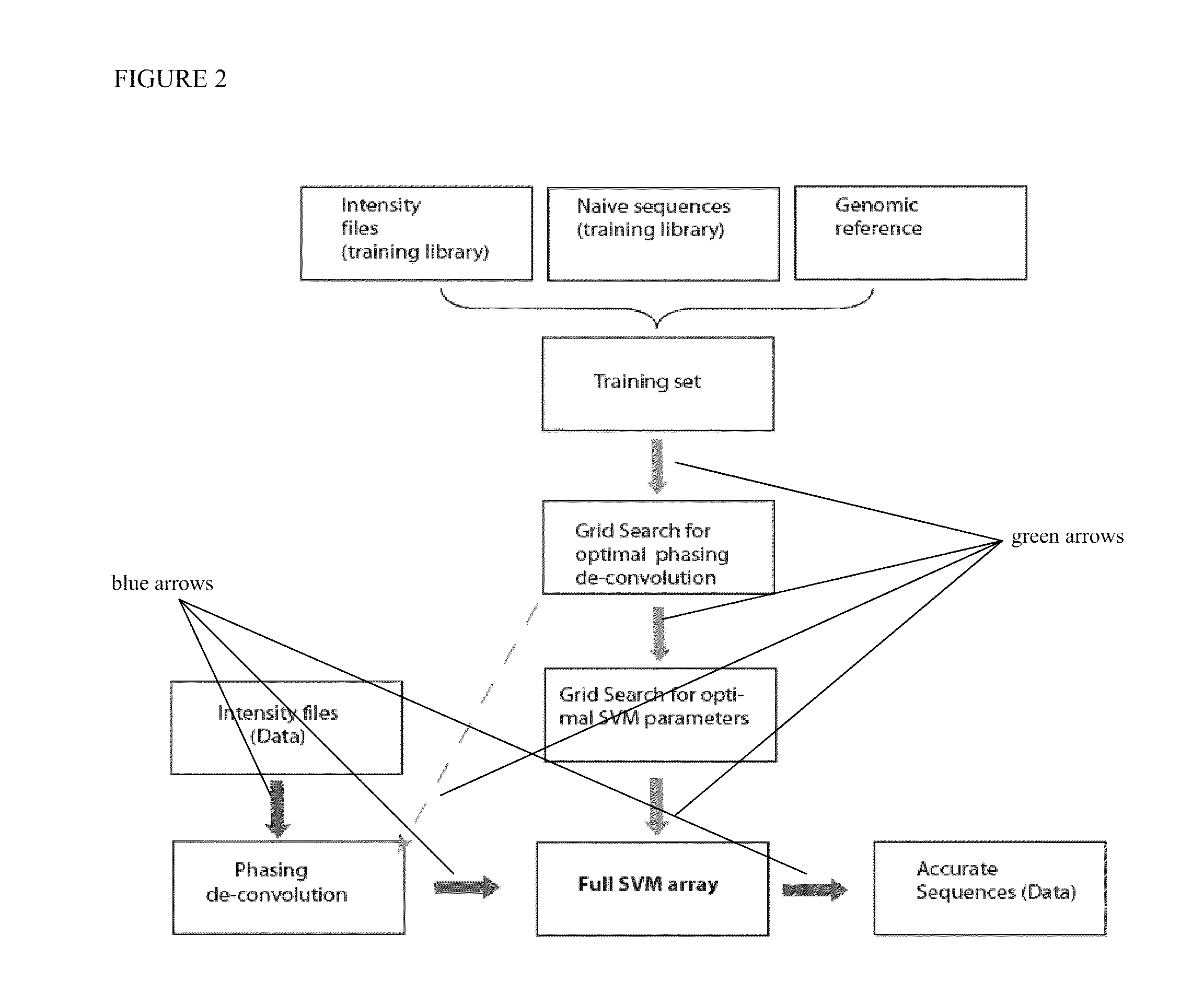Methods and systems of DNA sequencing
a technology of dna sequencing and methods, applied in the field of methods and systems of dna sequencing, can solve the problems of high error rate, next generation sequencing or high throughput sequencing, and achieve the effects of improving sequence determination, high throughput sequencing, and high error ra
- Summary
- Abstract
- Description
- Claims
- Application Information
AI Technical Summary
Benefits of technology
Problems solved by technology
Method used
Image
Examples
example 1
Creating a Mathematical Model for Solexa Non-stationary Noise Factors
[0103]The Illumina GA platform has almost no published literature regarding the exact data processing or the noise factors that are applied or introduced at each stage. Therefore, we started by constructing a comprehensive model describing the signal and non-stationary noise factors. Alta-Cyclic relies on this model, and the training stage is designated to find the best parameters that fit the model to the noise. In the following sections we describe the steps we took in order to develop the present model.
Demonstrating Linearity of the Intensity Values
[0104]First, we showed that the intensity values that are generated by the platform are the outcome of a linear transformation to the number of received photons. We checked whether the machine optic channel is linear—that is, that the intensity of the digital .tiff image is linearly correlated with the number transmitted photons. We did this by instructing the sequenc...
example 2
Benchmarking Alta-Cyclic on GAI Machines
[0118]We performed an SNP calling experiment on phi-X on the GAI machine using a 50 cycle run. Surprisingly, this yielded similar values for phasing as the GAII run (p1=0.9925, p2=0.9975) (FIG. 9). This may permit us to reduce the area of the grid search and speed training in the future. Overall, Alta-Cyclic increased the number of correct 50 nt reads by a factor of 1.52, reporting ˜1,450,000 correct reads, whereas the Illumina base caller reported ˜950,000 correct reads. The rate of miscalling SNPs with the Illumina pipeline was around 5.5% across all the cycles; whereas, the Alta-Cyclic miscall rate was 4.1%. The difference in the error rates was elevated for the last 15 cycles. The Illumina base caller missed 11% of the SNPs, but Alta-Cyclic only missed 7% (FIG. 10). Note that these results obtained with the old scanning buffer.
example 3
Determining the Accuracy of the Generative Random Walk Model
[0119]We evaluated the ability of the generative random walk model to predict sequence signals of Illumina GAII run with 101 cycles. As an input to the parameter inferring stage, we sequenced phi-X using 101 cycles, and divided the obtained sequences to two groups—training group, composed of 200 sequence types, and testing group composed of the rest ˜10,000 sequence types. We called the sequences the Illumina baseline base-caller as in Example 1. Then, we aligned the sequences of the entire library to the phi-X reference genome allowing mismatches, and we retained the signals that were associated with the training group, and averaged the signals of each sequence type. Using 500 runs of simulated annealing, we searched for the best p1, p2, p3, p4A-T parameters when minimizing 12 norm (we used the cross talk matrix obtained from the Illumina base-caller). The table below shows the searching space and the best value:
[0120]
Para...
PUM
| Property | Measurement | Unit |
|---|---|---|
| concentration | aaaaa | aaaaa |
| length | aaaaa | aaaaa |
| size | aaaaa | aaaaa |
Abstract
Description
Claims
Application Information
 Login to View More
Login to View More - R&D
- Intellectual Property
- Life Sciences
- Materials
- Tech Scout
- Unparalleled Data Quality
- Higher Quality Content
- 60% Fewer Hallucinations
Browse by: Latest US Patents, China's latest patents, Technical Efficacy Thesaurus, Application Domain, Technology Topic, Popular Technical Reports.
© 2025 PatSnap. All rights reserved.Legal|Privacy policy|Modern Slavery Act Transparency Statement|Sitemap|About US| Contact US: help@patsnap.com



